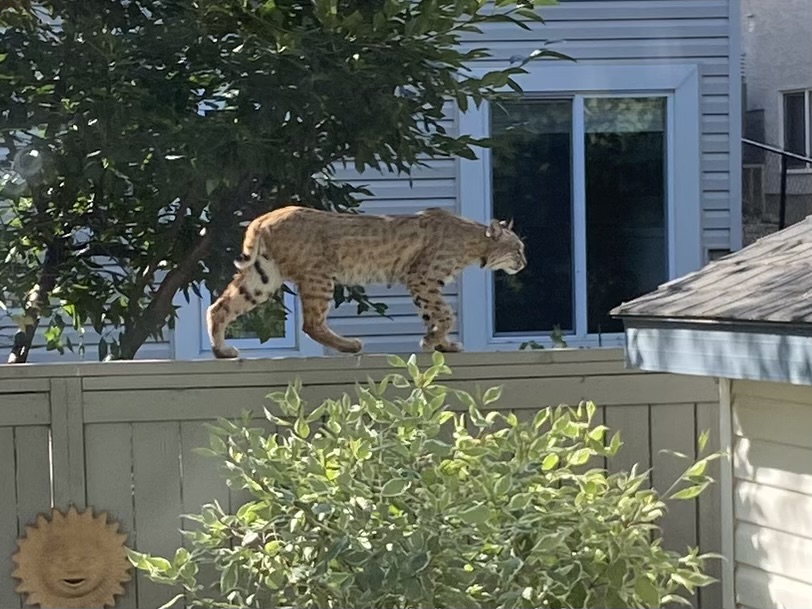In recent weeks, reported sightings of bobcats and even badgers have surfaced on local social media groups. The Government of Alberta says such encounters aren’t unusual — and knowing how to respond can help keep both people and animals safe.
Earlier this summer, a dog park in Airdrie was partially closed after a porcupine was spotted resting nearby.
And while no bears have been reported in Airdrie this year, a black bear seen on a trail behind Cochrane’s RancheHouse on Aug. 7 prompted that town to remind residents to be “bear smart” by putting waste carts out only on collection morning, removing food sources such as bird feeders and fallen fruit, keeping dogs leashed, and carrying bear spray.
Bobcats are naturally shy and most active at sunrise and sunset, though they may adapt to human activity and roam during the day. Twice the size of a domestic cat, with a short bobbed tail, black-tufted ears and dark markings, they feed mainly on rabbits, hares and small mammals. Attacks on humans are extremely rare, but small pets may be at risk. The province advises keeping cats indoors, supervising small dogs, and ensuring a bobcat has an escape route if it wanders onto your property.
Badgers, by contrast, spend much of their time underground, digging for prey such as ground squirrels. They usually avoid humans but will defend themselves if cornered. With strong claws and a powerful bite, they can cause serious injury. Giving them space and leashing dogs is the safest approach.
And while badgers work below the surface, another slow-moving neighbour prefers the treetops — porcupines. They are mostly nocturnal but may rest low in trees or on the ground during the day, making them more likely to cross paths with curious dogs. Porcupines cannot throw their quills, but can embed them with a quick slap of the tail. Raised quills, clattering teeth and vocalizing are signs to back away slowly. They may also chew on leather, wood and even vehicle brake lines in search of salt. Protecting valuable trees with aluminum flashing, storing tools indoors and keeping dogs leashed can help avoid trouble.
Sharing the night shift with porcupines are skunks, another animal best admired from a distance. They feed on insects and rodents, and while not usually aggressive, will stamp their feet, growl, raise their tails or hiss before spraying. That spray can cause watering eyes, nasal irritation and nausea, and can linger on pets and clothing. Removing outdoor food sources, closing off spaces under sheds and decks, and sealing them with ½-inch hardware cloth can help keep skunks away.
Coyotes are among the most adaptable of Airdrie’s wild visitors. Looking like a small German shepherd with a bushy tail, they thrive on a diet of rodents, rabbits and other small animals, and will take advantage of garbage, fallen fruit or pet food left outdoors. Never feed coyotes, intentionally or otherwise. If you encounter one, make yourself appear larger, wave your arms, throw objects toward it, and shout in a deep voice. Children should be taught to yell, look big and never run.
Rabbits and hares are common year-round, and while they might seem harmless, they can damage gardens, trees and shrubs. Removing food and shelter, fencing sensitive areas and using approved repellents can reduce the problem.
Deer also make occasional appearances in city limits, especially where green space provides cover. While generally timid, they can be aggressive when protecting fawns. Keep your distance, bring pets and children indoors if one wanders into your yard, and avoid feeding them. Drivers should take extra care in October–November and April–May, when vehicle collisions are more likely.
In all cases, officials say the same rule applies: never attempt to handle wild animals. Young left alone are often safe, as mothers may be away feeding. Injured wildlife is best left alone unless it poses a danger to the public. Encounters will continue year-round, and being prepared can help keep both people and wildlife safe.
Contacts
-
Report-A-Poacher: 1-800-642-3800
-
Alberta Institute for Wildlife Conservation (Madden): 403-946-2361
-
Calgary Wildlife Rehabilitation Society: 403-214-1312
-
More information: alberta.ca/wildlife
Sign up to get the latest local news headlines delivered directly to your inbox every afternoon.
Send your news tips, story ideas, pictures, and videos to news@discoverairdrie.com. You can also message and follow us on Twitter: @AIR1061FM.
DiscoverAirdrie encourages you to get your news directly from your trusted source by bookmarking this page and downloading the DiscoverAirdrie app.
